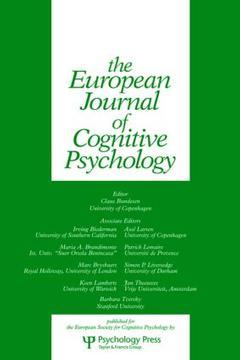Voluntary and involuntary control of automatic processing in spatial congruency tasks a special issue of the european journal of cognitive
Langue : Anglais

This special issue of the European Journal of Cognitive Psychology focuses on spatial congruency effects. The dominant view that has emerged after 50 years of research on this topic is that an automatic route processes task-irrelevant spatial information, while another, controlled, route supports rule-based response activation. However, in line with recent literature, this issue reports studies that show that what has been considered automatic, is in fact subject to various control processes. Consequently, in order to account successfully for congruency effects, dual-route models should be adapted so that they can account for between- and within-trial modulation of congruency effects. On the other hand, these studies also show that the relationships between stimulus and response representations that give rise to congruency effects are far more complex than considered so far. Therefore, integrative models for (spatial) congruency effects must indicate when (and how) a response will be activated on the basis of irrelevant stimulus information. The present set of papers not only addresses these issues and outlines possible starting points for future research, but also extends beyond spatial congruency to domains such as task-switching, conflict monitoring, priming, attention, dual-tasking and number processing. Most importantly, this special issue explicitly demonstrates the significance of congruency effects for the study of cognitive control in general.
B. Caessens, W. Notebaert, B. Burle, E. Soetens, Voluntary and Involuntary Control over Automatic Processing in Spatial Congruency Tasks: Editors' Introduction. B. St??rmer, E. Seiss, H. Leuthold, Executive Control in the Simon Task: A Dual-task Examination of Response Priming and its Suppression. B. Burle, W.P.M. van den Wildenberg, K.R. Ridderinkhof, Dynamics of Facilitation and Interference in Cue-priming and Simon Tasks. W.,Notebaert, F. Verbruggen, E. Soetens, A Sequential Analysis of Relevant and Irrelevant Information in the Stroop Task. W. Gevers, B. Caessens, W. Fias, Towards a Common Processing Architecture Underlying Simon and SNARC Effects. J. Memelink, B. Hommel, Attention, Instruction, and Response Representation. S. Rubichi, E. Gherri, R. Nicoletti, C. Umilt?á,,Modulation of the Vertical Simon Effect in Two-dimensional Tasks: The Effect of Learning. S. Bosbach, W. Prinz, D. Kerzel, Movement-based Compatibility in Simple Response Tasks. J. M??sseler, I. Koch, P. W??hr, Testing the Boundary Conditions for Processing Irrelevant Location Information: The Cross-task Simon Effect. J. Lupi?í??ez, M.J. Funes, Peripheral Spatial Cues Modulate Spatial Congruency Effects: Analyzing the "Locus" of the Cueing Modulation.
This special issue focuses on spatial congruency effects. The dominant view that has emerged after 50 years of research on this topic is that an automatic route processes task-irrelevant spatial information while another, controlled route, supports rule-based response activation.
Date de parution : 09-2005
Ouvrage de 176 p.
© 2024 LAVOISIER S.A.S.



